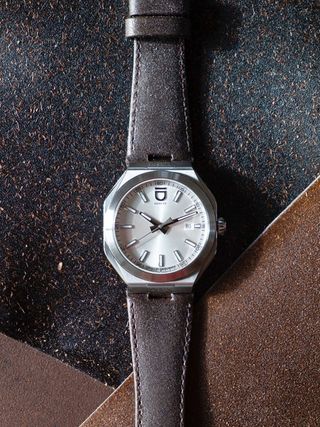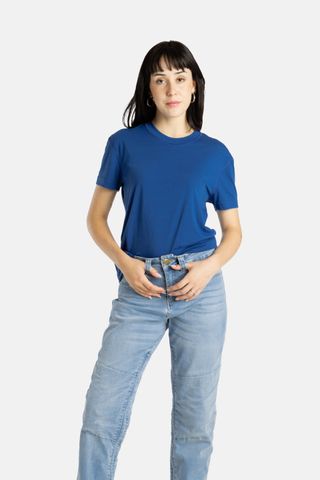As one of the most iconic jewelry brands, Cartier stands apart for its beautiful craftsmanship, designs, and innovation. This includes the recent buzzy launches of its Baignoire bangle and Mini Tank Louis watches, which reimagine heritage pieces that were originally debuted over 100 years ago. Cartier also stands apart because it is a brand that champions women. Not only does the brand put women at the forefront when it comes to jewelry designs, but it also supports women outside of the jewelry space. This includes the Cartier Women’s Initiative (CWI), a fellowship program launched in 2006 that drives change by empowering women entrepreneurs. Who What Wear was lucky enough to travel to Shenzhen, China, for the 2024 awards ceremony.
(Image credit: Cartier Women’s Initiative)
The 2024 fellows are changemakers who left us inspired by their innovative ideas and dedication to making a difference in the areas of equality, climate action, education, health, and more. For example, Sierra Kaur of Girls That Invest aims to close the wealth gap by teaching women about investing and finance. Sadriye Görece of BlindLook uses an AI-powered platform to make products and services comprehensive to people who are blind. Isabelle Kamariza of Solid’Africa provides nutrient-focused meals at affordable prices to patients to improve the availability of food in public hospitals.
These pioneers are also impacting change in the fashion industry. We spoke with the founders and CEOs of Biophilica, No Limbits, and Linus to hear more about how they are bringing change to the fashion space.

(Image credit: Biophilica)
How did the idea for your business come about?
I became deeply interested in sustainability after the birth of my daughter Nora in 2013. Increasingly alarmed by the prevalence of problematic chemicals in our everyday objects and surroundings—and the responsibility we share for our children’s future—my perspective had changed. I was constantly asking myself, How does the future look for Nora and other children and their children?
This lead me to change course. After a 17-year-long career, I went back to college (the Royal College of Art). In 2018, I was inspired by the leaves that covered the pavement as I walked down Kensington High Street. I had the idea of creating a low-impact material made from green waste. This was where Biophilica began, and my motivation today remains unchanged: to be part of the solutions for a better planet for future generations to inherit.

(Image credit: Cartier Women’s Initiative)
Can you share more about the development of Treekind and how it is being used today, and tell us more about Biophilica’s sustainability efforts?
Developed in the Biophilica London laboratory, Treekind combines plant waste (lignocellulose) from garden and agricultural sources with algae to create a flexible, leather-like material that is recyclable and home compostable thanks to its natural formulation, which is designed to break down in soil or water within one year, with the help of microbes. Fully scaled, one kilogram of Treekind material uses less than 0.1% of the water used in conventional leather processing, has zero toxic chemicals in its formulation, and because of its plant content, boasts a significantly reduced carbon footprint compared to leather and roughly half that of PU and PVC.
While there are many plant-based leather alternatives that exist, there are very few that are truly free of PU. These partly plastic materials cannot be recycled, and fewer still are home compostable. As a result, there has been exciting interest in Treekind, and we are working with many fashion brands including ID Genève Watches, Bestseller, and Been London following pilot trials in 2022 and 2023.
Would you recommend pursuing programs like the CWI to other entrepreneurs?
Wholeheartedly yes. As a business, we believe that to drive true meaningful change in creating a more sustainable fashion future, we need to collaborate. By pursuing programs like the CWI, you can access incredible networks of like-minded innovators and changemakers who can share their own insights and learnings, as well as inspire new solutions and collaborations. The CWI has in a very short amount of time already offered an immense amount of valuable support.

ID Genève Watches
Treekind Strap
What’s your vision for the future of Biophilica?
Treekind was created as part of my desire to contribute to a more responsible future. I wanted to ensure we had a material that could both degrade in nature as well as have the capability to be recycled with the right infrastructure (shout-out to governments who need to develop this infrastructure further). Whilst a more circular fashion industry is certainly one part of the solution for a more sustainable industry, the reality of executing an infrastructure to handle textile recycling at scale is years away. With this in mind, in tandem with the fact that brands are not slowing down the speed and volume in which they are producing, compostable material solutions with a minimal carbon footprint like Treekind are a more immediate answer.
Our focus for 2024 is to continue scaling our material production to meet growing industry demand. As part of developing Treekind, we also developed a 100% biobased foam and Brightbond—a 100% biobased adhesive that can laminate our material without using petrochemicals. Brightbond is now becoming a really exciting stand-alone product that we’re excited to accelerate the production of in the coming months.

(Image credit: No Limbits)
Tell me how your business came about.
I lost my leg in 2018. I struggled with a lot of things, but dressing myself was the first challenge of the day when I got my prosthetic. It was so bulky, nothing would fit over the top, it was wearing holes in things, and I’d have to go to the bathroom and completely undress multiple times a day to make adjustments to my prosthetic. So I was 22 years old wearing sweatpants
that were three sizes too large because nothing else worked for me.
I started altering my own clothing on a sewing machine. I was really involved in the amputee community and started altering clothes for friends who also struggled with clothing, and then by word of mouth, I was on a sewing machine all day and night. I realized that there was such a gap in the market for accessible clothing that I decided to start what is now No Limbits.
After launching a successful preorder campaign, we appeared on Shark Tank and got a deal with Mark Cuban and Emma Grede. No Limbits became very visible and continued to grow and launch new products and collections. Now, we serve four segments of the disabled community: people with lower-limb difference, wheelchair users, people with limited dexterity in their hands or arms, and those with sensory processing sensitivities.

(Image credit: Cartier Women’s Initiative)
Do you get to hear stories from the No Limbits community about how your designs have impacted their lives?
We get messages every day that we’ve impacted someone’s life and independence. The ones that stick out to me are the messages when someone hasn’t been able to independently wear a pair of pants in a long time, sometimes years. And suddenly, they have a pair made specifically for their needs. It seems simple, but it can be an emotional thing to be able to wear what you want to wear and present yourself how you want to present. We’re on pace to impact 30,000 people with accessible clothing this year.

No Limbits
Adaptive Wheelchair Pants
How has being part of the Cartier Women’s Initiative impacted you and your business thus far?
The network of Cartier Women’s Initiative is massive, and I’ve been paired with several experts in the social-impact space to grow my business. Through this mentorship, we’ve started to develop a new channel and gain access to new partnerships that I otherwise would not have had access to.
We’ve had workshops on public speaking and media training, which is such a huge part of entrepreneurship, but one that no one really talks about. I feel much more confident in these situations than I had before.

No Limbits
Adaptive Sensory Tee
What are your expectations for the impact it will have in the future?
I am very excited to build relationships with the other Cartier Women’s Initiative fellows. Entrepreneurship can be such a lonely journey, and I’m excited to have other people who are on the same journey, especially other women working in the social-impact space.
Additionally, the issue of accessibility in apparel isn’t unique to the U.S. This is a global problem, and I would have no idea where to start international expansion without the help of the Cartier Women’s Initiative mentors. I’m excited to increase our reach through the program.

No Limbits
Adaptive Khaki Unlimbited Pants
What is your ultimate dream for No Limbits?
I have two goals for No Limbits. One, I hope that anyone who is struggling with clothing due to a disability can come to No Limbits and find options that excite them—not just something that works but options that make them feel confident and independent.
Two, I hope that we can introduce adaptive clothing as a new category within apparel. I envision every brand one day having an accessible line, and I hope that No Limbits paves the way for this reality so that people with disabilities can have the same fashion experience as their non-disabled peers.

(Image credit: Linus)
How did you start Linus? What was the impetus?
Since childhood, sustainability has been a core interest of mine. At just 4 years old, I learned about recycling at school and immediately asked my mother if we were recycling our household waste. During the same period, I remember preaching to store attendants about the cruelty behind fur coats. As I grew older, my passion for environmental issues deepened, and early on, I understood the profound impact the fashion industry has on the ecosystem and labor relations.
After earning a degree in business administration, I gained experience in various international consumer goods industries. However, I yearned to work on something more purposeful, aligned with my lifelong interest in sustainability. Coming from a family of entrepreneurs, I had never envisioned starting my own business until I encountered a problem that I wanted to solve.
As an advocate for comfortable and casual styles, I often wore low-heeled shoes. After experiencing discomfort and consulting specialists, I was diagnosed with ligament laxity, necessitating shoes with arch support. During my search, I noticed a glaring gap in the market: Finding shoes that were comfortable, sustainable, and stylish was nearly impossible. This realization led me to create Linus in 2018, a sustainable lifestyle brand built on the pillars of comfort, sustainability, and timelessness.

(Image credit: Cartier Women’s Initiative)
Do you have any advice for would-be sustainable-fashion entrepreneurs?
I believe striving for maximum sustainability should be a prerequisite for any new business, especially in the fashion industry, which is one of the most polluting sectors globally. This pursuit must be genuine and ongoing because there is always room for improvement. Modern entrepreneurs need to aim to be change agents, working toward an environmentally, socially, and financially more sustainable future. Once an entrepreneur embraces this responsibility, the likelihood of greenwashing diminishes significantly because decision-making becomes clearer when guided by solid values. Moreover, with younger generations increasingly engaged in environmental issues, embedding sustainability in your business enhances long-term success. At Linus, we’ve found that our commitment to sustainability drives our sales, but our motivation has always been to be more sustainable for the sake of impact, not just profit.

Would you recommend pursuing programs like the CWI to other entrepreneurs?
Absolutely. The CWI’s global program offers a prestigious platform to broadly showcase what our businesses are achieving. It’s also a unique opportunity to connect with impact entrepreneurs worldwide, allowing us to exchange insights on our respective challenges and realities. So far, the program’s mentorship sessions, the leadership courses we are having, and the INSEAD program we will have have been of immense value. Additionally, for companies seeking funding to accelerate growth, the Cartier award provides financial incentives, as do other initiatives within the program. And there are so many other opportunities that I’m still learning about. I can only highly recommend applying!

What’s next for Linus?
Having recently surpassed 400 points of sale in Brazil, we’ve expanded our operations internationally. Our aim is to solidify Linus’s presence beyond sandals, establishing it as a sustainable lifestyle brand and accelerating our global relevance, becoming a worldwide reference. We are already present in Uruguay, Chile, Peru, as well as Europe, the Middle East, and Oceania.

Is there anything else about Linus or your path to the CWI that you’d like to highlight?
Through Linus, I have the opportunity to work every day toward two interconnected goals: offering more sustainable consumption alternatives and promoting female leadership. Women, who are often the most affected by climate disasters, are also more likely to make sustainability-focused decisions when in leadership positions. This is why over 80% of our team is composed of women. Being selected as a finalist for the Cartier Women’s Initiative is incredibly rewarding. It serves as international recognition that we are on the right path and that it is possible to drive positive change while maintaining financial health. We started the company with just $10,000, and all the funding since then has come from reinvesting our revenues.
Source link
https%3A%2F%2Fwww.whowhatwear.com%2Ffashion%2Fcartier-womens-initiative-awards-2024
#Cartier #Empowering #Changemaking #Fashion #Entrepreneurs



















